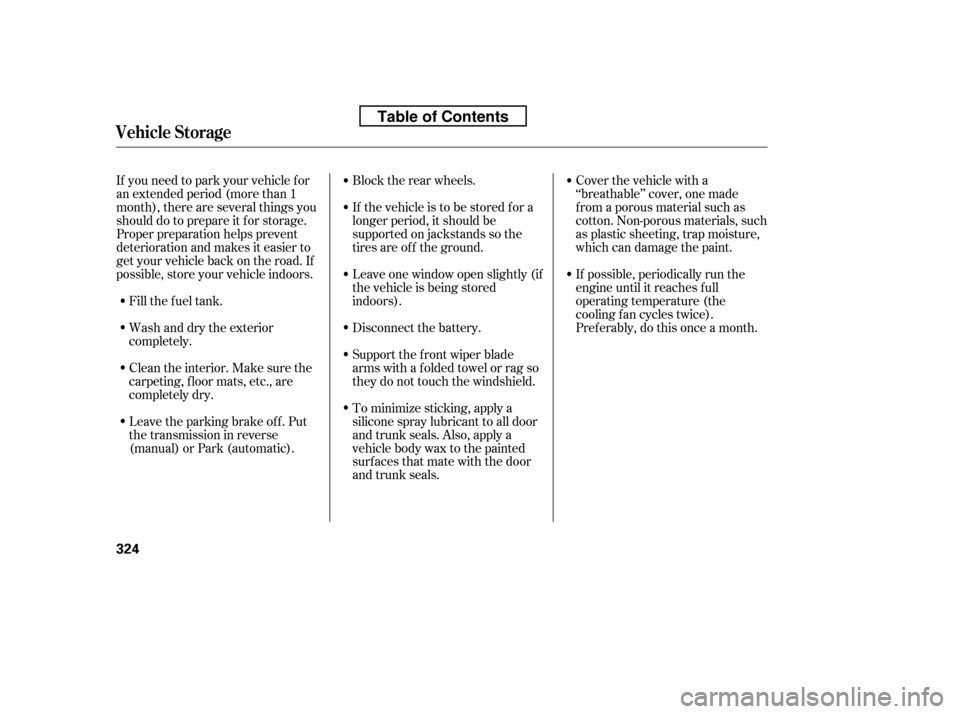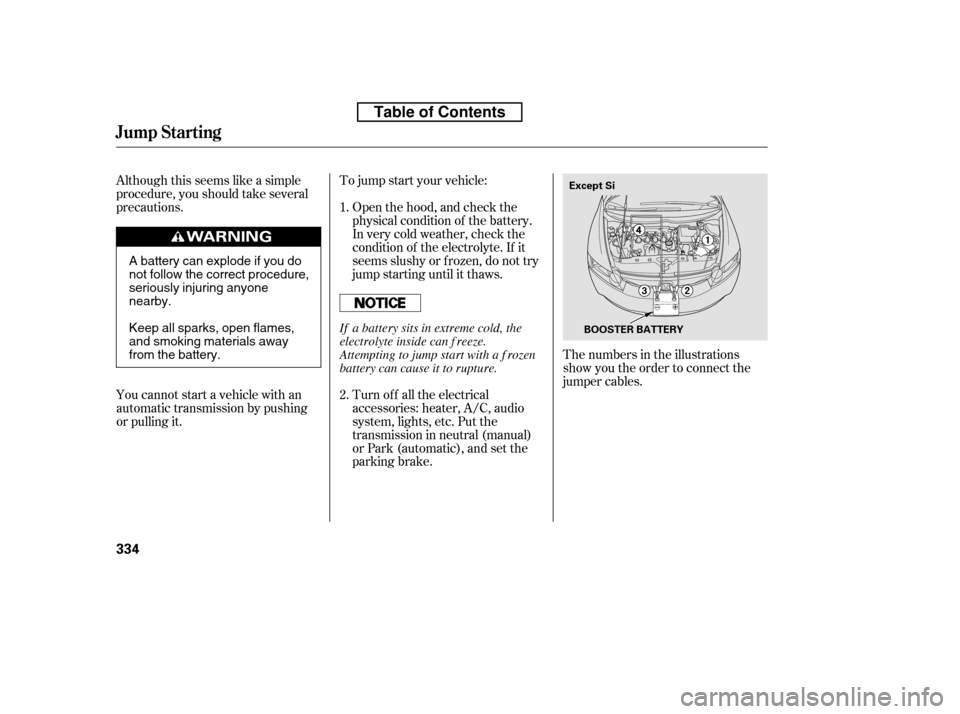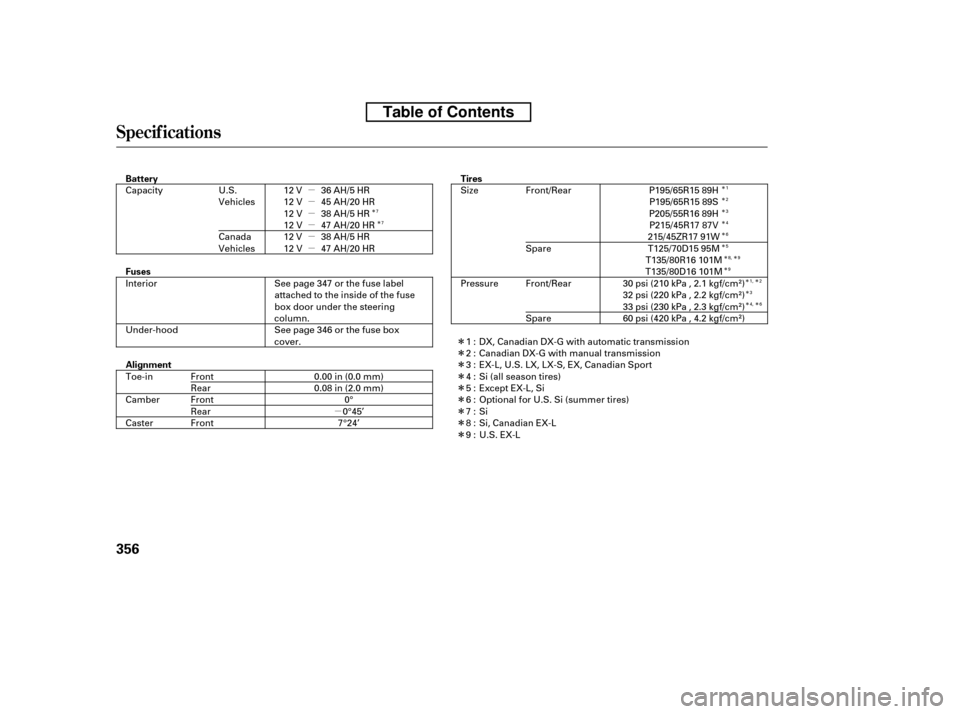Page 338 of 387

Fill the f uel tank.Block the rear wheels.
If the vehicle is to be stored f or a
longer period, it should be
supported on jackstands so the
tires are of f the ground.
If you need to park your vehicle f or
an extended period (more than 1
month), there are several things you
should do to prepare it f or storage.
Proper preparation helps prevent
deterioration and makes it easier to
get your vehicle back on the road. If
possible, store your vehicle indoors. Leave one window open slightly (if
the vehicle is being stored
indoors).Cover the vehicle with a
‘‘breathable’’ cover, one made
f rom a porous material such as
cotton. Non-porous materials, such
as plastic sheeting, trap moisture,
which can damage the paint.
To minimize sticking, apply a
silicone spray lubricant to all door
and trunk seals. Also, apply a
vehiclebodywaxtothepainted
surfaces that mate with the door
and trunk seals.
Support the f ront wiper blade
arms with a f olded towel or rag so
they do not touch the windshield.
Disconnect the battery. If possible, periodically run the
engine until it reaches f ull
operating temperature (the
cooling f an cycles twice).
Pref erably, do this once a month.
Wash and dry the exterior
completely.
Cleantheinterior.Makesurethe
carpeting, floor mats, etc., are
completely dry.
Leave the parking brake off. Put
the transmission in reverse
(manual) or Park (automatic).
Vehicle Storage
324
Table of Contents
Page 341 of 387

Turn on the hazard warning lights,
and turn the ignition switch to the
LOCK (0) position. Have all
passengers get out of the vehicle
while you change the tire.
Park the vehicle on f irm, level, and
non-slippery ground. Put the
transmission in Park (automatic)
or reverse (manual). Apply the
parking brake.
Open the trunk. Raise the trunk
f loor by lif ting up on the back edge.
Take the tool case out of the spare
tire.
Unscrew the wing bolt, and take
the spare tire out of its well.
If you have a f lat tire while driving,
stop in a saf e place to change it.
Drive slowly along the shoulder until
you get to an exit or an area to stop
that is far away from the traffic lanes.
Thecompactsparetireissmaller
than a standard tire, and it will affect
the vehicle’s handling. Drive
cautiously when the spare is
mounted on your vehicle.
Thesizedifferencemayalsocause
damage to the dif f erential, so do not
mount the compact spare on the
f ront. If either f ront tire goes f lat,
removethereartireonthatsame
side, mount the compact spare tire
on the rear, then mount the rear tire
on the f ront.
5.
4.
3.
2.
1.
CONT INUED
On Si model only
Changing a Flat T ire
T aking Care of t he Unexpect ed
327
SPARE TIRE
TRUNK FLOOR JACK TOOL CASE
The vehicle can easily roll off
the jack, seriously injuring
anyone underneath.
Follow the directions for
changing a tire exactly, and
never get under the vehicle
when it is supported only by thejack.
Table of Contents
Page 346 of 387

Diagnosing why the engine won’t
start f alls into two areas, depending
on what you hear when you turn the
ignition switch to the START (III)
position:You hear nothing, or almost
nothing. The engine’s starter
motor does not operate at all, or
operates very slowly.
You can hear the starter motor
operating normally, or the starter
motor sounds like it is spinning
f aster than normal, but the engine
does not start up and run. When you turn the ignition switch to
the START (III) position, you do not
hear the normal noise of the engine
trying to start. You may hear a
clicking sound, a series of clicks, or
nothing at all.
Check these things:
Check the transmission interlock.
If you have a manual transmission,
the clutch pedal must be pushed
all the way to the f loor or the
starter will not operate. With an
automatic transmission, it must be
in Park or neutral. Turn the ignition switch to the ON
(II) position. Turn on the
headlights, and check their
brightness. If the headlights are
very dim or do not come on at all,
the battery is discharged. See
on page .
Turn the ignition switch to the
START (III) position. If the
headlights do not dim, check the
condition of the f uses. If the f uses
areOK,thereisprobably
something wrong with the
electrical circuit f or the ignition
switch or starter motor. You will
need a qualif ied technician to
determine the problem. See on page .334
348
Nothing Happens or the Starter
Motor Operates Very Slowly
Jump Starting
Emergency T owing
If theEngineWon’tStart
332
Table of Contents
Page 348 of 387

Although this seems like a simple
procedure, you should take several
precautions.To jump start your vehicle:
The numbers in the illustrations
show you the order to connect the
jumper cables.
Turn of f all the electrical
accessories: heater, A/C, audio
system, lights, etc. Put the
transmission in neutral (manual)
or Park (automatic), and set the
parking brake.
Open the hood, and check the
physical condition of the battery.
In very cold weather, check the
condition of the electrolyte. If it
seems slushy or f rozen, do not try
jump starting until it thaws.
You cannot start a vehicle with an
automatic transmission by pushing
or pulling it. 1. 2.
Jump Starting
334
Except Si
BOOSTER BATTERY
A battery can explode if you do
not follow the correct procedure,
seriously injuring anyonenearby.
Keep all sparks, open flames,
and smoking materials away
from the battery. If a battery sits in extreme cold, the
electrolyte inside can f reeze.
Attempting to jump start with a f rozen
battery can cause it to rupture.
Table of Contents
Page 362 of 387

�µ�µ
If your vehicle needs to be towed,
call a prof essional towing service or
organization. Never tow your vehicle
with just a rope or chain. It is very
dangerous.
The operator
loads your vehicle on the back of a
truck.
Therearetwowaystotowyour
vehicle: If , due to damage, your vehicle must
be towed with the f ront wheels on
the ground, do this:
Release the parking brake.
Shif t the transmission to neutral.
Leave the ignition switch in the
ACCESSORY (I) position so the
steering wheel does not lock.
The tow
truck uses two pivoting arms that go
under the f ront tires and lif t them of f
the ground. The rear tires remain on
the ground. With the f ront wheels on the ground,
do not tow the vehicle more than 50
miles (80 km), and keep the speed
below35mph(55km/h).
Start the engine.
Press on the brake pedal. Move
the shif t lever through all its
positions.
Leave the ignition switch in the
ACCESSORY (I) position so the
steering wheel does not lock.
Release the parking brake.
Turn of f the engine.
Shif t to D position and hold f or 5
seconds, then to N.
Manual transmission:
Automatic transmission:
Flat -bed Equipment
Wheel-lif t Equipment
T his is the best way to
transport your vehicle.
This is an acceptable
way to tow your vehicle.
Emergency T owing
348
Improper towing preparation will
damage the transmission. Follow the
above procedure exactly. If you cannot
shif t the transmission or start the
engine (automatic transmission), your
vehicle must be transported with the
f ront wheels of f the ground.
Table of Contents
Page 366 of 387
The engine number is stamped into
the engine block. It is on the f ront.
The transmission number is on a
label on top of the transmission.
Identif ication Numbers
T echnical Inf ormation
353
MANUAL TRANSMISSION
NUMBER
ENGINE NUMBER
ENGINE NUMBER
AUTOMATIC/MANUAL
TRANSMISSION NUMBER
Except Si Si
Table of Contents
Page 368 of 387

�µ�µ
�µ �µ�µ �µ �µ�µ�µ�µ�µ�µ�µ�µ�µ�µ
�Î �Î �Î�Î�Î�Î�Î �Î�Î�Î�Î�Î
�Î�Î�Î�Î�Î�Î�Î�Î�Î�Î
�Î
�Î
�Î �Î
Specif ications
T echnical Inf ormation
355
Air Conditioning
Capacities
Lights
Refrigerant type
Charge quantity
Lubricant oil type
HFC-134a (R-134a)
14.1 15.9 oz (400 450 g) SP-10
12 V 60 W (HB3) 12 V 51 W (HB4)
12 V 24/2 CP
12 V 21 W
12 V 21/5 W
12 V 2 CP
12 V 21 W
12 V 3 CP
12 V 21 W
4.8 US qt (4.5
)
1.8 US qt (1.7
)
1.6 US qt (1.5
)
1.19 US gal (4.5
)
1.80 US gal (6.8
)
4.6 US qt (4.4
)
4.4 US qt (4.2
)
5.8 US qt (5.5
)
6.08 US qt (5.75
)
2.5 US qt (2.4)
1.40 US gal (5.3
)
1.77 US gal (6.7
)
2.6 US qt (2.5
)
1.7 US qt (1.6
)
1.5 US qt (1.4
)
1.37 US gal (5.2
)
1.72 US gal (6.5
)
3.9 US qt (3.7
)
3.7 US qt (3.5
)
4.8 US qt (4.5
)
13.2 US gal (50
)
Fuel tank
Engine
coolant
Engine oil Manual
transmission
fluid Automatic
transmission
fluid
Windshield
washer
reservoir Headlights
Front turn signal/side marker/
Parking lights
Rear turn signal lights
Stop/Taillights
Rear side marker lights
Back-up lights
Taillights
High-mount brake light
Fog lights
License plate lights
Ceiling light
Spotlights
Trunk light 12 V
12 V
12 V
12 V
5W
8W
8W
5W
12 V 55 W
Including the coolant in the reserve tank and that remaining in the
engine
Reserve tank capacity: 0.11 US gal (0.4
)
Excluding the oil remaining in the engine High Low
A/T
M/T
A/T
M/T
Change Total
U.S. Vehicles
Canada
Vehicles Approx.
Except Si
Change
Including filter
Without filter
Total
ChangeTotal
Change Total (Amber)
(Amber)
(H11)
Si
Except DX, Canadian DX-G
1: 2: 3:4:5:
13
34334
3434343434
2
4
5 3
Table of Contents
Page 369 of 387

�µ
�µ �µ�µ�µ�µ�µ
�Î�Î�Î�Î�Î�Î�Î�Î�Î
�Î
�Î�Î �Î�Î
�Î
�Î �Î
�Î �Î�Î
�Î
�Î�Î
�Î�Î
Specif ications
356
Fuses
Alignment
Battery
Tires
P195/65R15 89H
Interior
Under-hood
Toe-in
Camber
Caster 7°24’0°45’
0°
0.08 in (2.0 mm)
0.00 in (0.0 mm)
Capacity 12 V
12 V
12 V36 AH/5 HR
38 AH/5 HR
45 AH/20 HR
47 AH/20 HR
12 V
12 V 38 AH/5 HR
47 AH/20 HR
12 V T135/80R16 101MT125/70D15 95M
215/45ZR17 91W P215/45R17 87V
P205/55R16 89H P195/65R15 89S
Size
Pressure
See page 347 or the fuse label
attached to the inside of the fuse
box door under the steering
column.
See page 346 or the fuse box
cover. 60 psi (420 kPa , 4.2 kgf/cm
)
33 psi (230 kPa , 2.3 kgf/cm)
32 psi (220 kPa , 2.2 kgf/cm)
30 psi (210 kPa , 2.1 kgf/cm)
T135/80D16 101M
Front Rear
FrontRear
Front Front/Rear
Spare
U.S.
Vehicles
Canada
Vehicles
Front/Rear
Spare
Si (all season tires)
Canadian DX-G with manual transmission
DX, Canadian DX-G with automatic transmission
Except EX-L, Si
EX-L, U.S. LX, LX-S, EX, Canadian Sport
1: 2:3:4:5:6:7:8:9: Optional for U.S. Si (summer tires)Si
U.S. EX-L
Si, Canadian EX-L
3
1 2 45
7
7 6
9 4, 6
3
1, 2
8, 9
Table of Contents